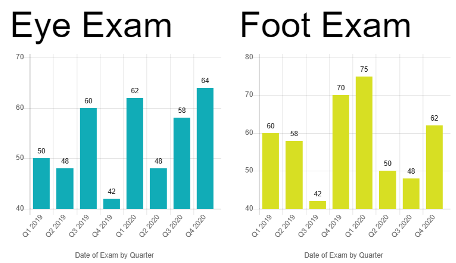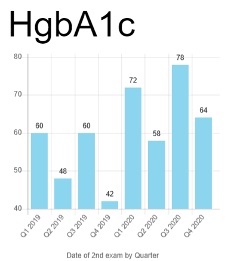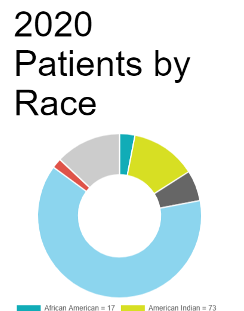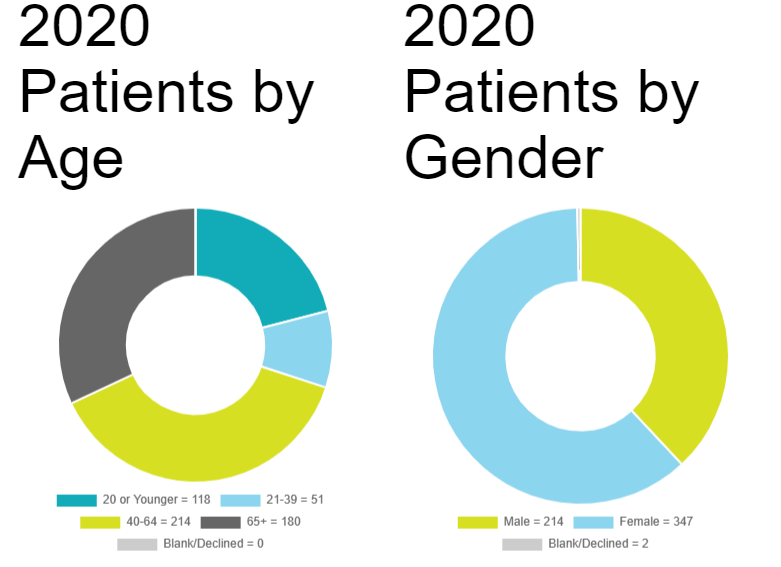Introduction
The simulation activity generated specific data about Mercy Medical Center’s performance. The presented dashboard metrics depict statistical information related to diabetes care, which allows for evaluating the quality of service at the given facility. Among the diagrams presented in Appendix, it is reasonable to draw attention to the Eye Exam and Foot Exam charts representing the number of patients participating in these examination procedures. The 2020 Patients by Gender visual depicts that the facility had 563 patients. As for the two bar charts above, 232 individuals (41.21%) participated in the eye exams, and 235 (41.74%) took the foot exams in the same year.
The obtained percentages demonstrate that the metrics do not meet the benchmarks set forth by federal healthcare policies. On the one hand, the Healthy People 2030 (n.d.) initiative indicated that 70.3% of adults diagnosed with diabetes should have an eye exam annually. On the other hand, the American Diabetes Association established a national benchmark of above 76% for annual food examinations (Sam, 2023). This information demonstrates that the selected facility significantly underperforms regarding diabetes diagnostic activities. This evaluation is all-sufficient because it reveals organizational performance pitfalls, indicating that no additional information is needed.
Consequences
The failure to meet the specified metrics contributes to a few adverse outcomes. First, the problem demonstrates that some patients will not be diagnosed with diabetes comorbidities early, which will significantly worsen their health outcomes. Possible difficulties include severe medical conditions, such as blindness and foot ulcers (Lundeen et al., 2019; McDermott et al., 2023). This state of affairs will contribute to increased medical spending because treating diseases is more expensive than preventing them.
Second, not meeting the prescribed benchmarks can hurt the organizational mission and vision. As a traditional healthcare facility, the Mercy Medical Center aims to provide people with the required care and help patients prevent health issues. Insufficient screening rates imply that the organization cannot achieve these goals.
One should acknowledge that benchmark underperformance exists because of a few challenges. Lundeen et al. (2019) stipulate that insufficient eye exam rates are found among racial minorities because of stakeholders’ low health literacy. Thus, some medical professionals may be unaware of the benchmark, while patients may not know they should be subject to this assessment.
In addition to ethnic groups, foot exam prevalence is low among socioeconomically disadvantaged groups and people without insurance (McDermott et al., 2023). Some specific assumptions underlie the presented conclusions to shed light on the problem. There are racial disparities in the healthcare industry, and diabetic patients are not free from the issue. Moreover, another suggestion implies that individuals do not have a perceived need for care of this type.
Evaluating Benchmark Underperformance
While the two dashboard metrics were deemed problematic in the selected organization, it is rational to choose one and comment on its potential for improvement. To determine the most significant gap, one should look at the gap between the actual percentage values and the required benchmarks. Thus, the difference is 29.09% for the eye exams and 34.26% for the foot examinations. This finding demonstrates that the assessment of diabetic patients’ feet introduces the greatest underperformance degree and implies that the most significant number of patients are deprived of adequate care. That is why one can deservedly state that the foot exam represents the most widespread benchmark underperformance.
A detailed analysis of the problem under consideration reveals that it will notably hurt the entire community that the Mercy Medical Center serves. As has been mentioned above, diabetic patients are subject to foot ulcers. This information indicates that healthcare organizations must deliver appropriate services to ensure fewer individuals suffer from this condition.
Buschkoetter et al. (2019) argue that timely diagnostic procedures can help detect and prevent this issue from occurring. A failure to cope with it can result in severe problems for patients. McDermott et al. (2023) state foot ulcers are associated with high recurrence rates, amputation incidence, and mortality. In other words, the given inefficiency can result in tragic consequences for individuals and the entire community.
I think that the selected issue is crucial and essential for modern society, which denotes that improving the quality of care is necessary. An excellent opportunity exists to cope with the problem because the Mercy Medical Center only needs to make more patients participate in foot exams. The only task is to determine individuals more eligible for this service. Thus, the further section will comment on this finding and offer an intervention to target the appropriate stakeholder group.
Advocating for an Ethical and Sustainable Action
The available scholarly evidence demonstrates that being a representative of minorities is an essential barrier to foot exam participation. McDermott et al. (2023) mention that Hispanic and Asian individuals experience the lowest levels of care in this regard. Since these individuals do not engage in the required number of foot assessment activities, they more severely suffer from the complications mentioned above.
That is why offering and implementing an action that will target this stakeholder group is ethical. These individuals do not need to do anything because it is the responsibility of the Mercy Medical Center and other healthcare institutions. They must provide all individuals, regardless of race, ethnicity, gender, and religion, equal and adequate care access.
The only possible action to improve performance is inserting the American Diabetes Association’s benchmark into the organizational culture. The healthcare facility and its staff should understand that they must involve at least 76% of all diabetic patients in foot examinations. This solution is ethical because it eliminates racial disparities in the industry.
In addition to that, it is essential to increase health literacy within the stakeholder group (Lundeen et al., 2019). When people are more aware of their rights, they will be more likely to request the needed services if providers fail to do so. Such a comprehensive approach to the problem can lead to improved outcomes.
Conclusion
Reviewing the dashboard metrics of the Mercy Medical Center has revealed that this facility suffers from significant underperformance. The comparison of the visuals presented with the federal benchmarks demonstrates that the healthcare institution has insufficient rates of eye and foot exams among diabetic patients. When people have this diagnosis, blindness, and foot ulcers are among the frequent and severe comorbidities, which denotes that healthcare professionals should monitor, prevent, and manage these issues.
At present, foot exam underperformance is more widespread and influential because representatives of minority groups do not have adequate access to the selected assessment procedure. Thus, the medical facility should incorporate the appropriate benchmark into its culture on an organizational level to increase the exam rate and provide stakeholders with improved health outcomes.
References
Buschkoetter, K. L. M., Powell, W., & Mazour, L. (2019). Implementation of a comprehensive diabetic foot exam protocol in rural primary care. Online Journal of Rural Nursing and Health Care, 43-63. Web.
Healthy People 2030. (n.d.). Increase the proportion of adults with diabetes who have a yearly eye exam – D-04. Web.
Lundeen, E. A., Wittenborn, J., Benoit, S. R., & Saaddine, J. (2019). Disparities in receipt of eye exams among Medicare part B fee-for-service beneficiaries with diabetes – United States, 2017. Morbidity and Mortality Weekly Report, 68(45), 1020. Web.
McDermott, K., Fang, M., Boulton, A. J., Selvin, E., & Hicks, C. W. (2023). Etiology, epidemiology, and disparities in the burden of diabetic foot ulcers. Diabetes Care, 46(1), 209-221. Web.
Sam, B. (2023). Improving diabetic foot examination rate in a primary care clinic. Convention. Web.
Appendix



